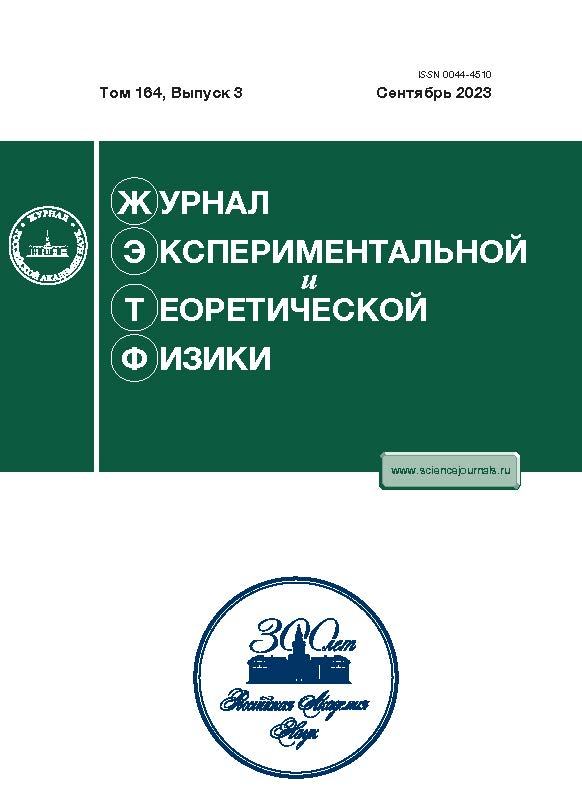Satellites of the Dipole-Forbidden Transitions to the Low-Lying 2S1/2 and 2D3/2,5/2 Excited States of K, Rb, and Cs Atoms in the Spectra of Gas-Phase Mixtures with CF4
- Авторлар: Alekseev V.A.1, Vartanyan T.A.2, Pazgalev A.S.3, Serdobintsev P.Y.4
-
Мекемелер:
- Institute of Silicate Chemistry, Russian Academy of Sciences
- National Research University ITMO
- Ioffe Institute
- St. Petersburg State University
- Шығарылым: Том 164, № 3 (2023)
- Беттер: 328-339
- Бөлім: Articles
- URL: https://transsyst.ru/0044-4510/article/view/653648
- DOI: https://doi.org/10.31857/S004445102309002X
- EDN: https://elibrary.ru/KBWOUP
- ID: 653648
Дәйексөз келтіру
Аннотация
The luminescence excitation spectra of the D1 resonance line of atoms K, Rb, and Cs in gas mixtures with CF4 are found to contain satellite transitions, which correspond to the transition of an atom to the states (n – 1)d 2D3/2,5/2 and (n + 1)s 2S1/2, where n = 4, 5, and 6 for K, Rb, and Cs, respectively, with the simultaneous excitation of CF4 molecule vibrations at the IR active mode frequency ν3 with a quantum energy of 1283 cm–1. These satellite transitions are A(ns 2S1/2) + CF4(ν3 = 0) + hν → A((n – 1)d 2D3/2,5/2) + CF4(ν3 = 1) and A(ns 2S1/2) + CF4(ν3 = 0) + hν → A((n + 1)s 2S1/2) + CF4(ν3 = 1), where A = K, Rb, and Cs. The appearance of an optical coupling between the upper and lower states of these asymptotically (at
Авторлар туралы
V. Alekseev
Institute of Silicate Chemistry, Russian Academy of Sciences
Email: vadim-alekseev@mail.ru
St. Petersburg, 199034 Russia
T. Vartanyan
National Research University ITMO
Email: tvaza@mail.ru
Russia, 197101, St. Petersburg
A. Pazgalev
Ioffe Institute
Email: vadim-alekseev@mail.ru
St. Petersburg, 194021 Russia
P. Serdobintsev
St. Petersburg State University
Хат алмасуға жауапты Автор.
Email: vadim-alekseev@mail.ru
St. Petersburg, 199034 Russia
Әдебиет тізімі
- Л. И. Гудзенко, С. И. Яковленко, ЖЭТФ 62, 1686 (1972).
- J. Szudy and W. E. Baylis, Phys. Rep. 266, 127 (1996).
- R. Hotop and R. Niemax, J. Phys. B 13, L93 (1980).
- J. C. White, G. A. Zdasiuk, J. F. Young, and S. E. Harris, Opt. Lett. 4, 137 (1979).
- V. A. Alekseev, A. A. Pastor, A. S. Pazgalev, P. A. Petrov, P. Yu. Serdobintsev, and T. A. Vartanyan, JQSRT 258, 107339 (2021).
- В. А. Алексеев, Н. К. Бибинов, И. П. Виноградов, Опт. Спектр. 73, 269 (1992).
- В. А. Алексеев, А. А. Пастор, П. Ю. Сердобинцев, Т. А. Вартанян, Письма ЖЭТФ 114, 60 (2021).
- V. A. Alekseev and N. Schwentner, Chem. Phys. Lett. 463, 47 (2008).
- V. A. Alekseev, J. Grosser, O. Ho mann, and F. Rebentrost, J. Chem. Phys. 129, 201102 (2008).
- G. A. Pitz and M. D. Anderson, Appl. Phys. Rev. 4, 041101 (2017).
- M. Carlos, O. Gruson, C. Richard, V. Boudon, M. Rotger, X. Thomas, C. Maul, C. Sydow, A. Domanskaya, R. Georges, P. Soulard, O. Pirali, M. Goubet, P. Asselin, and T. R. Huet, JQSRT 201, 75 (2017).
- G. Moe, A. C. Tam, and W. Happer, Phys. Rev. A 14, 349 (1976).
- V. Dubourg, M. Ferray, J. P. Visticot, and B. Sayer, J. Phys. B 19, 1165 (1986).
- E. J. Breford аnd F. Engelke, Chem. Phys. Lett. 75, 132 (1980).
- D. Edvardsson, S. Lunell, and Ch. M. Marian, Mol. Phys. 101, 2381 (2003).
- Y. Lee, S. Lee, and B. Kim, J. Phys. Chem. A 112, 6893 (2008).
- M. D. Rotondaro and G. P. Perram, Phys. Rev. A 57, 4045 (1998).
- S. Brode, Ch. Kolmel, H. Schi er, and R. Ahlrichs, Z. Phys. Chem. 155, 23 (1987).
- В. А. Алексеев, Опт. Спектр. 130, 1343 (2022).
- S. E. Harris and J. C. White. IEEE J. Quant. Electron. 12, 972 (1977).
- A. Kramida, Yu. Ralchenko, J. Reader, and NIST ASD Team (2020), NIST Atomic Spectra Database (version 5.8) [Online]. Available: https://physics.nist.gov/asd [May 31, 2021]; National Institute of Standards and Technology, Gaithersburg, MD; DOI: https://doi.org/10.18434/T4W30F
Қосымша файлдар









